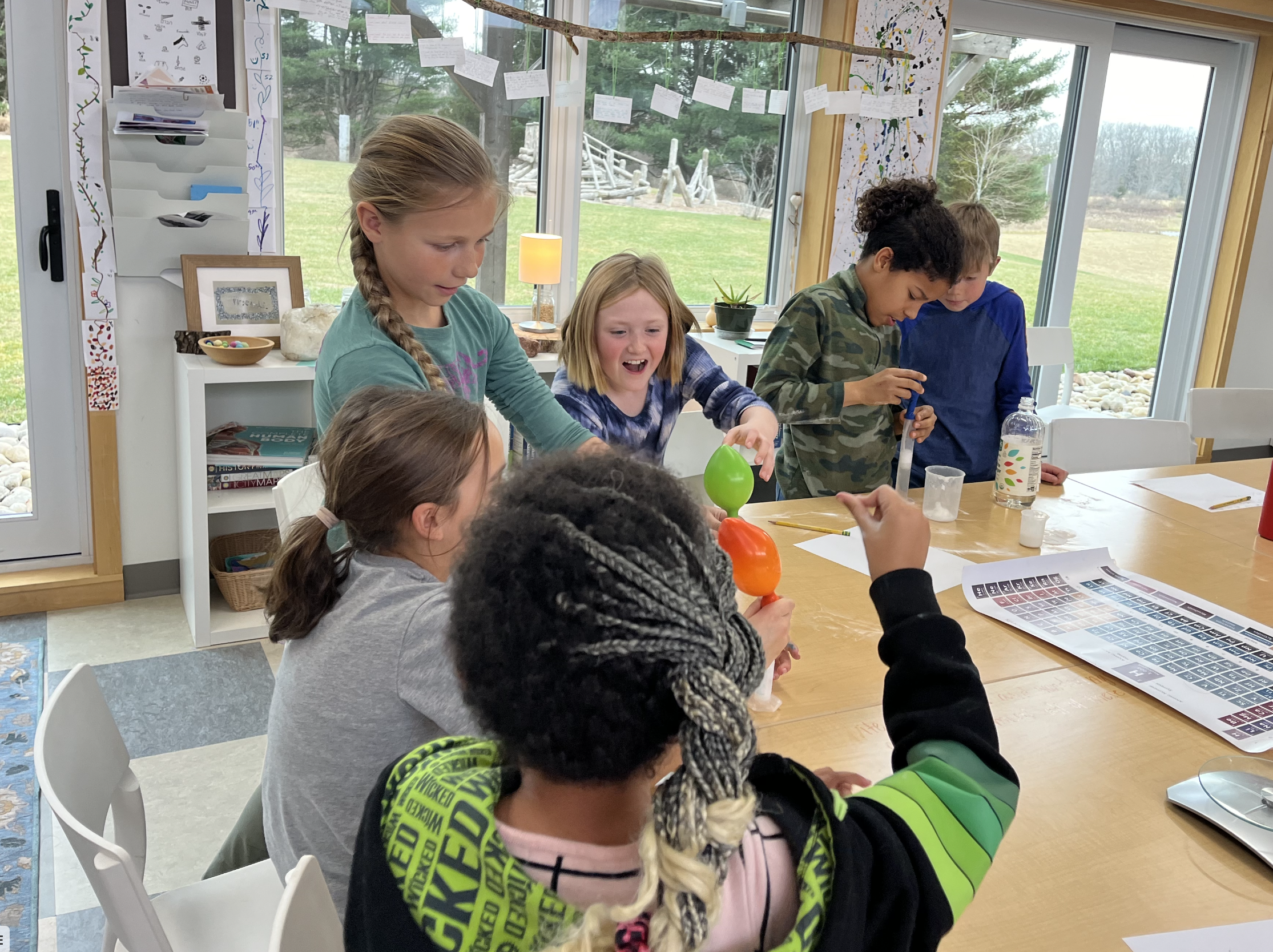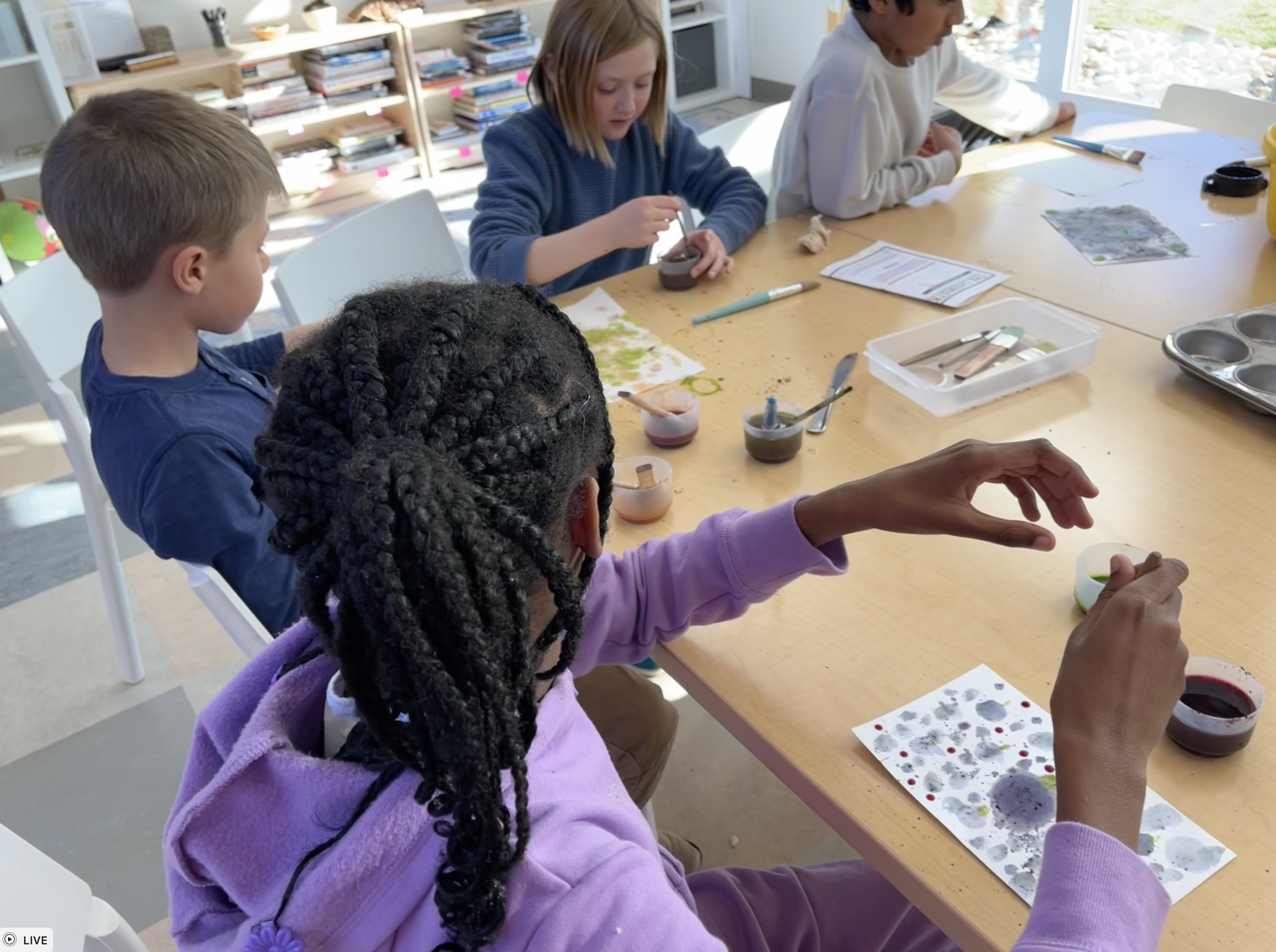
Interdisciplinary Science Blog



From Cave Art Pigments to Catalase: Interdisciplinary Learning in Experiment Studios
By Jennifer Staple-Clark, Founder and Executive Director
During the three weeks between the Thanksgiving Holiday and Winter Break, we implemented an Intersession Studio period, consisting of 50-minute sessions each afternoon. All K-6 students participated in a variety of studios that nurtured their interests, including Experiments, Improv, Rhythm and Beats, Dance, and Storytelling.
Our Grade 3-6 students immersed themselves in the Experiments Studio over several days, exploring scientific thinking and experimental design. Their initial experiment involved combining vinegar with baking soda, where students made predictions about the outcome, ranging from an "explosion" to a "volcano." After conducting the experiment, students analyzed the chemical reaction [NaHCO3 + HC2H3O2 → CO2 + H2O + NaC2H3O2], discussing compounds and elements. Our Grade 5/6 students recently delved into elements and compounds, and they shared insights with our Grade 3/4 students, who had recently explored bubbles in their classroom. Collaboratively, students modified the experiment to capture carbon dioxide gas by using balloons. Working in pairs, they designed their own measurements for baking soda and vinegar, and they had great anticipation as the balloons expanded with carbon dioxide.
In a subsequent Experiment Studio, students explored another chemical reaction, this time with Hydrogen Peroxide and a potato slice. After looking at what elements make up hydrogen peroxide (H2O2), the students themselves deduced that the bubbles this time were O2, and they applied what they had learned in the prior Experiments Studio to realize that the other compound produced is water. We discussed how potatoes have catalase which produces the chemical reaction, and then we wondered what other vegetables and fruits have catalase. The students explored lots of samples from our greenhouse (corn, ground cherries, garlic, sweet potato, kale, onion, mint, parsley, chives, and rosemary), and some others like lemon, banana, and banana peel. The student excitement was palpable as they mixed Hydrogen Peroxide with different varieties of vegetable and fruit options, and they made observations. After all of the experimentation concluded, the students shared their findings with each other. After finding that the banana had the most catalase and therefore produced the most oxygen gas, they drew upon their experience with the prior Experiment Studio to decide to capture all of the oxygen gas produced by banana's catalase into a balloon, too. They observed that there is a lot more carbon dioxide produced by the prior reaction than oxygen produced by this catalase reaction.
The next day, students joined together for another Experiments Studio. They started by hypothesizing what might happen if we mix lemon juice and baking soda, and students enthusiastically anticipated bubbles. They squeezed a lemon, designed their own experiments, and were excited to see the fizzing bubbles created by the chemical reaction. Students realized that like our baking soda and vinegar reaction, our lemon juice reaction, too, was producing carbon dioxide. We looked at the compounds and chemical equations for this reaction, and then thought about acidity. The students wondered what other fruits, vegetables, and materials also are acidic and therefore would produce carbon dioxide bubbles. Students had a wide array of options to choose from: bananas, apples, oranges, grapefruit, potatoes, pine needles, rosemary, parsley, chives, cabbage, soil from around campus, and more. They joined into groups to do many experiments of their own design, and they recorded amounts of materials used, made observations, and shared their observations with the larger group. We thought together about the pH scale, and where lemons are on the pH scale, and then worked our way to thinking about the pH of each of our materials today based on the amount of bubbles produced during the chemical reaction. One of the students said that she wished that we had limes available as an experimental option since she thought that lemons and limes are similarly sour and may have similar acidity, so we did that experiment the next day, too.
The next Experiments Studio combined art and chemistry. The day before, our Grade 3-6 students visited the Yale Art Gallery. Our Grade 5/6 students had in prior weeks considered the chemical compounds of paint pigments used by artists from the cave art period to the Renaissance period, and then to the Impressionist period of Monet and Van Gogh. Meanwhile, our Grade 3/4 students had also explored the artistic representations of many artists at the Yale Art Gallery. On this day in our Experiments Studio, we experimented to create paint pigments, and our students then painted incredible creations! We began the investigation by listening to the story of how a group of four boys discovered the Lascaux Cave Art in 1940, and they thought about the natural pigments used 17,000 years ago in cave art. We learned in our exploration of cave art that dirt had been mixed with a binder like animal fat all of those years ago, and so we began by mixing soil with olive oil, and found it to be a great way to paint! We also had a variety of other materials for the students to choose from: blended and then strained spinach, carrots, black cherries, and blueberries. We also had available two types of soil from our campus: one from the wet meadow and another from the dry meadow. We also had a variety of local wild berries for the students to mash with rocks in pails. While the students were creating their pigments to use for painting, we looked at the chemical structure of the molecules that give each of the pigments their colors, including chlorophyll in spinach and beta carotene in the carrots. Beautiful paintings emerged from our students!
Over the course of four sessions, the Experiments Studio blended the scientific process with art, creativity, and their gardening experiences. At Slate School, the students experience boundless connections in their interdisciplinary learning journey.
About The Blog Author, Jennifer Staple-Clark
For nearly 25 years, Jennifer Staple-Clark has been a leader in nonprofit innovation, and she currently leads two nonprofit organizations: Unite For Sight and Slate School. In 2000, Jennifer, who was then a sophomore at Yale University, founded Unite For Sight in her dorm room. Unite For Sight is now a leader both in global health education and in providing cost-effective care to the world's poorest people.
A cum laude graduate of Yale University, Jennifer received a Bachelor of Science Degree in Anthropology as well as in Molecular, Cellular, and Developmental Biology. Early in her career, Jennifer taught high school environmental science and chemistry, where she brought project-based learning to the independent school where she was teaching. She received a national educator award for her work. After dedicating herself to being a high school educator, Jennifer completed two years of medical school at Stanford University School of Medicine before shifting to pursue her passionate interest in global health and eliminating patient barriers to care through building the nonprofit Unite For Sight into an organizational leader in the field. After more than a decade dedicated solely to Unite For Sight, in 2017, Jennifer founded Slate School, an innovative 501(c)3 nonprofit K-12 curiosity-driven and nature-based school in Connecticut. As part of her work as Founder and Executive Director of Slate School, Jennifer draws on her science, medical, anthropology, and public health background to integrate curiosity-driven, interdisciplinary chemistry, biology, and physics into the Upper Elementary classrooms. She is also closely involved in the Upper School interdisciplinary curriculum development.